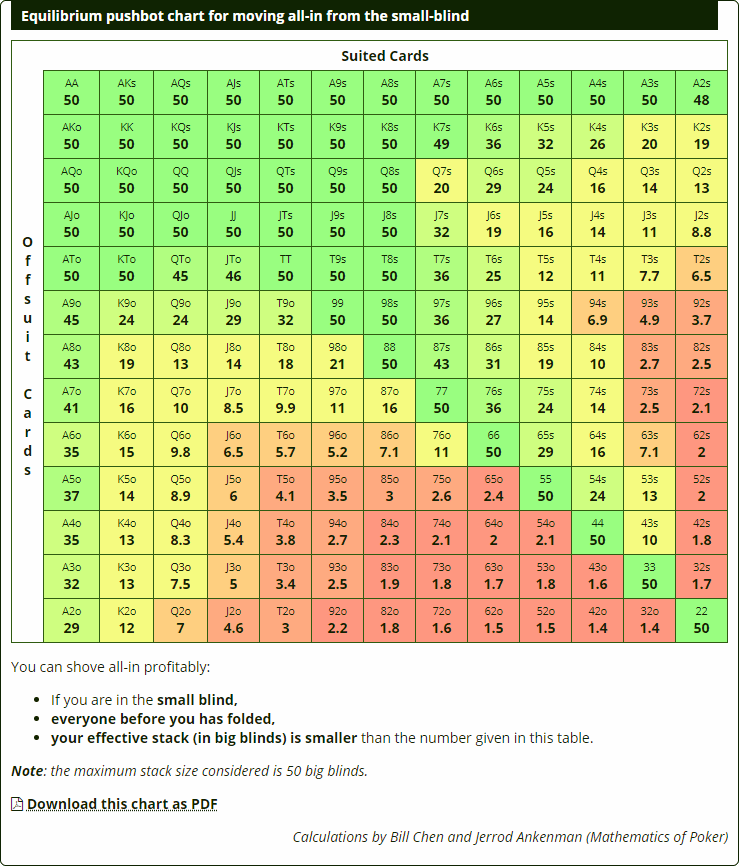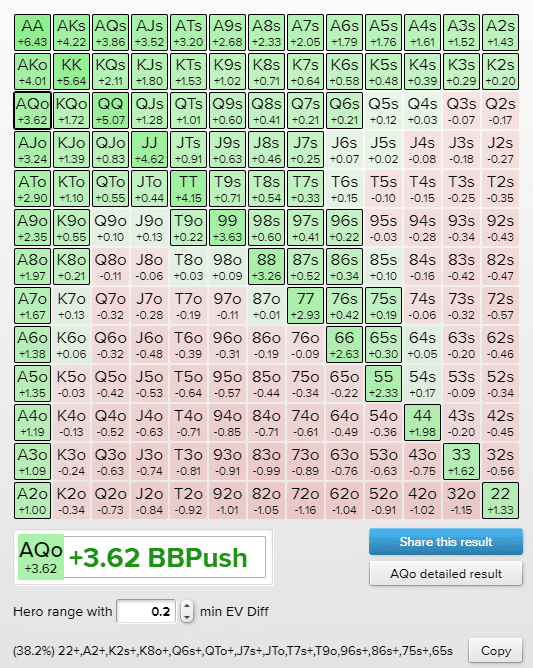Poker Shove Chart
In that case, I would refer to the 10BB chart: If someone in front of you has already raised or shoved in, you should avoid conflict mostly. It takes a much better hand to call a shove than to make a shove. Look at the ten BB chart, you can defend with the three’s and often the two’s. Detailed overview of ICMIZER push fold Charts. Hand Ev Chart - allows to see how equity of our hand will depend on range of our opponent. I describe different typical shapes of Hand EV charts like and show how to use charts in various tournament spots.
These Push Fold Charts will help you understand when you need to either fold or shove your entire stack when you are short stacked in poker tournaments. Please use these charts as a study tool to help you improve your understanding of push fold scenarios.
In addition to these charts, you can download our Poker Coaching Mobile App to access charts and quizzes or study them in a browser by viewing our Push Fold App. Once you have studied your push / fold ranges, challenge yourself by taking the Push / Fold Quiz to see how you do!
I have been playing and winning at poker since 2008 and have put together some charts for you. The chart will work well both online and live, in cash games and tournaments. In order to make things simple, I have given you an easy to read, yet comprehensive, range chart that covers virtually every pre-flop decision you could face at the poker table. The Best Short Stack Poker Strategy (Free Poker Chart) People often ask me what is the best short stack poker strategy these days. This means when you are down to 10 or 20 big blinds in a cash game or a poker tournament by the way. This tool has changed the way professionals play poker: 90% of all high stakes players make use of Pio Solver. ICMizer is the best tool when it comes to working out pre-flop ranges for Sit & Gos. Whether you want to know what hands to re-shove or open-shove, this tool will give you the answers. Hand2note, is a great poker tracker software.
These charts are meant to be used for study purposes. Make sure to check the Terms and Conditions of the sites that you play on to see if this is against the rules to use any of these while you’re in a poker game. If it is against the TOC of the game you are in, you should not use these tools while you play.

Nash Poker Shove Chart
 I received an email question from GolfPro today about playing a short stack in an MTT:
I received an email question from GolfPro today about playing a short stack in an MTT:The answer to this is a resounding Yes! We poker players absolutely have a range of hands we should be open-shoving with when short-stacked. In fact, this is one of the few areas of poker that is actually 'solved' by the math geeks of poker. The solution method derives from something called the Nash Equilibrium method.
In game theory, Nash equilibrium is a method of solving so-called 'non-cooperative games' (like poker) that involve two or more players. Nash assumes that each player is playing perfectly; i.e,. everyone knows the strategies and best decisions of the other players, and no player has anything to gain by changing only their own strategy unilaterally. Said another way: Hero and Villain are in Nash equilibrium if Hero is making the best decision he can, taking into account Villain's strategy, and Villain is making the best decision he can, taking into account Hero's strategy.
 Uh, okay. What's this got to do short stack poker? Answer: the math boys have used this method to work out the chip-EV calculations for different hand ranges, given an assumed payout structure of an MTT, for different stack sizes and table sizes. The result of this is something called Push-Fold charts. Google/Bing/Yahoo the term and you'll find lots of information on this approach to short stack play. Or, even better, let Uncle Bug do it for you: Just go to a site like Exceptional Poker to get the charts. For instance, here's a chart for open-shoving when you're at 10 big blinds at a full ring table:
Uh, okay. What's this got to do short stack poker? Answer: the math boys have used this method to work out the chip-EV calculations for different hand ranges, given an assumed payout structure of an MTT, for different stack sizes and table sizes. The result of this is something called Push-Fold charts. Google/Bing/Yahoo the term and you'll find lots of information on this approach to short stack play. Or, even better, let Uncle Bug do it for you: Just go to a site like Exceptional Poker to get the charts. For instance, here's a chart for open-shoving when you're at 10 big blinds at a full ring table:If you were in MP with, say four players left to act, and the action folds to you and there are not yet Antes involved, you should be open shoving with: 22+ A7s+ A5s-A3s ATo+ K8s+ KJo+ Q8s+ QJo J8s+ T8s+ 98s. If you have a shorter stack than 10bb, just select the appropriate tab on the web page and go from there. Same with 6-max and heads-up play. (Note that if you have more than 10bb, you should be open-raising to less than all-in.)
Poker Shove Chart
Now, are the charts on a site like this perfect for all situations? No, of course not. The charts don't take into account things like individual villain traits and tendencies, and by default they have to assume a specific payout structure that may or may not match the tourney you're playing in (e.g., this particular web site assumes a very top-heavy payout structure). They also assume your opponents are playing perfectly and adjusting accordingly. This is clearly not true...... but it turns out that this doesn't actually matter much. Most experts agree that if you use correct short-stack push-fold charts like the ones found on Exceptional Poker you will have a significant advantage over ~60% of the players you find at low and mid-stakes online tourneys, and probably a high as 70%+ in your local casino live low-stakes tourneys. Pay attention- this is a really significant edge, folks.
Note that if you're new to push-fold Nash charts, you might think the hand ranges seem pretty wide. Well, yes, they are. But the math don't lie, and countless computer simulations by lots of smart poker/math guys have proven that these charts represent the game theory optimal solution and are correct.
Note also that the Nash ranges assume you're up against opponents who play perfectly. When they make mistakes or don't play optimally, you profit even more by using the charts. Note however that if your opponent's mistakes are significantly large you can make even more profit by deviating your push/fold ranges from the chart. Usually this means tightening up a wee bit. But don't go too far, or you will be the one straying too far from Nash's recommendations-- and therefore be the one playing sub-optimally.

All-in for now...